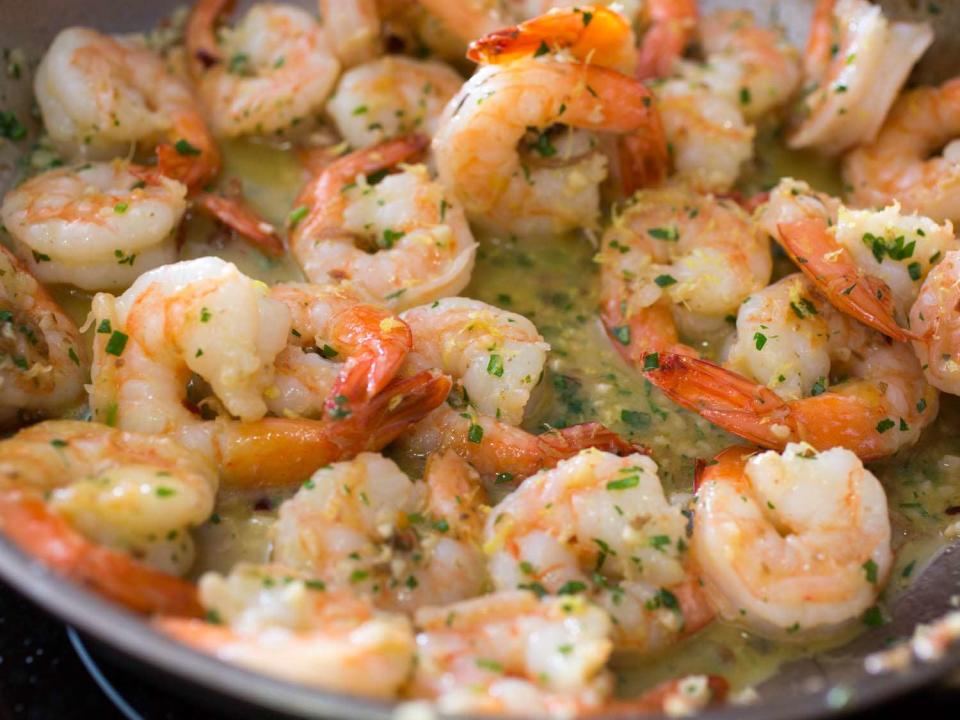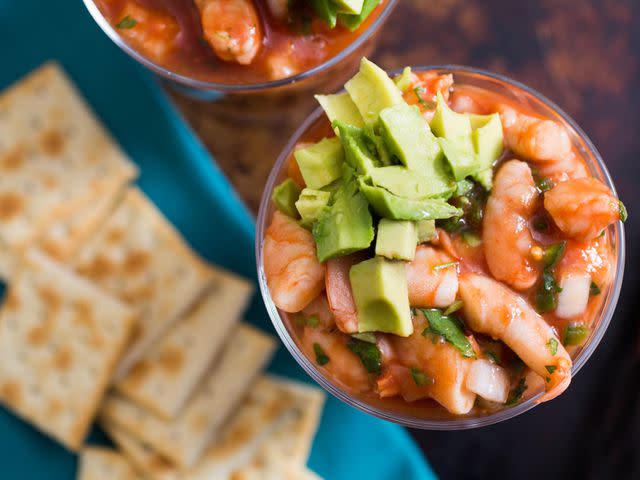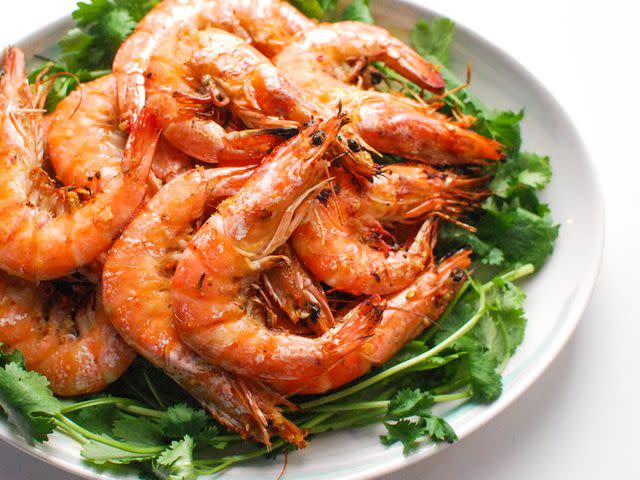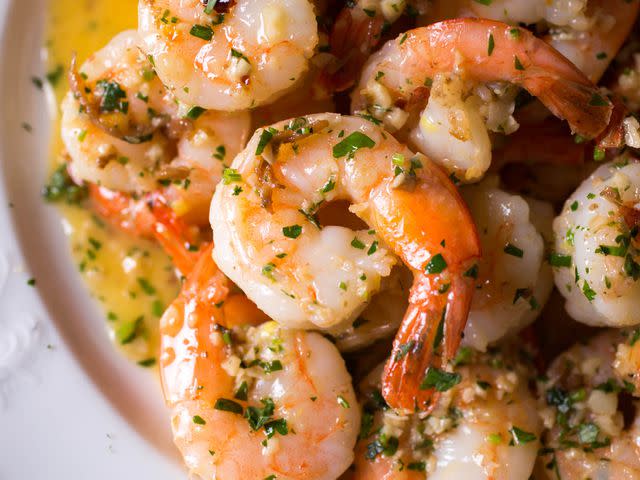Easy Techniques to Improve Any Shrimp Recipe
Say goodbye to mushy, rubbery shrimp with these simple hacks.

Serious Eats / Vicky Wasik
I was raised in what you might call a shrimp cocktail family—each and every one of us is a complete fanatic. To this day, it's not uncommon for an oversized platter of poached shrimp and a bowl of horseradish-heavy cocktail sauce to stand in as my dinner. Unfortunately, not all shrimp cocktail is created equal—something you have probably learned the hard way if you've ever picked up one of those prepackaged supermarket varieties. Poorly cooked shrimp can range from mushy and watery to flavor-sapped to downright rubbery. And it only takes one bad experience to make you shy away from ordering shrimp at a restaurant, let alone cooking it yourself.
But perfectly cooked shrimp are another thing entirely. They're sweet and juicy, with a tender, plump body and a slightly crisp bite. So wouldn't it be nice if there was a foolproof way to guarantee excellent shrimp every single time?
Oh wait, there is.
More specifically, there are multiple ways, each specially tailored to the method you're using to actually cook the shellfish. We've done a whole lot of testing to figure out just what makes shrimp go from treasure to trash; luckily, getting it right just takes a little know-how.

Serious Eats / Vicky Wasik
First things first, though, you want to start with good shrimp. If the mere act of shopping for the stuff already feels overwhelming, be sure to check out our shrimp shopping guide and find out why raw frozen shrimp can be your totally reliable and delicious best friend.
Start With a Dry Brine, No Matter How You're Cooking
Before we dive into the details, there's one technique that we've found improves all shrimp, regardless of cooking method: a quick dry brine with salt and baking soda. It may sound minor, but the combination works wonders: the salt helps keep the shrimp nice and moist as they cook, while alkaline baking soda delivers a crisp, firm texture. You're looking for about 1 teaspoon of kosher salt and 1/4 teaspoon of baking soda for every pound of shrimp; give it a quick toss and rest the shrimp in the fridge for anywhere from 15 minutes to about an hour.
Cold-Start Poaching

Serious Eats / Vicky Wasik
When it comes to poaching shrimp, getting the cooking just right is especially crucial—most poached shrimp are served chilled and minimally dressed, which means there's no warm, delicious sauce to compensate for a botched job. Whether you're tackling a classic shrimp cocktail (or our favorite Mexican-style version), a cooling shrimp-studded corn and tomatillo salad, or a chilled Vietnamese-style seafood pasta salad, we've found that starting the brined shrimp in cold water is a complete game-changer.
Slowly raising the temperature of the water means that the shrimp will cook more slowly—it may not be the fastest method, but that expanded window of time significantly slows down how quickly the shrimp can slip into over-cooked territory. Better yet, shrimp cooked this way have a more tender texture than shrimp tossed into simmering water and pulled when they hit the same internal temperature.
It's an approach that echoes the benefits of cooking sous-vide: "At a boiling-hot 212°F (100°C), the outsides of your shrimp are going to get tough no matter what," Kenji explains. "But by using the cold water-start method, you can restrict that upper bound." The sweet spot for perfectly cooked edge-to-edge tender shrimp, just stop heating your water once it hits 170°F (77°C). It's that simple (and at roughly seven minutes, still pretty darn quick).
Grilling Tips

Serious Eats / J. Kenji López-Alt
Grilling is a tricky business when you're working with fast-cooking proteins like shrimp—you want the smoky char that only searing-hot flames can produce, but not at the expense of overcooking your food. We already know that a salt and baking soda brine improves the texture and juiciness of shrimp, but adding a little sugar to the mix can help encourage better, faster browning and caramelization once they hit the heat. In other words, you'll get that pleasant pairing of sweetness and bitterness without the tough, rubbery shrimp beneath.
For even better results, try grilling your shrimp nested on skewers. The nesting decreases each shrimp's individual surface area, so it's less likely to overcook or dry out. To catch all the hows and whys, plus more handy tips for grilling shrimp, just check out The Food Lab's 5 Steps to the Best Grilled Shrimp and put it all to the test with a simple plate of garlic and lemon-spiked skewers.

Serious Eats / Shao Z.
Not afraid of some extra work? Ditch the brine and sugar solutions and try keeping the shells (and heads!) on your shrimp. Those exoskeletons enhance flavor and help shield the delicate meat from the heat, keeping them extra tender. The only downside is a little mess, since you'll need to peel the shrimp table-side.
Sautées and Stir-Fries

Serious Eats / Vicky Wasik
As for stovetop preparations, cooking shrimp perfectly is as simple as starting them in that baking soda and salt dry brine. Well, that and knowing when to stop: as soon as they've lost their translucency and developed that hallmark pink hue, it's time to pull them. Sometimes, this can mean removing them from the wok or sauté pan partway through—just check out our recipes for stir-fried shrimp with eggs and Chinese chives, Spanish-style garlic shrimp (gambas al ajillo), Japanese shrimp in chile sauce, spice-encrusted Cajun shrimp, or classic shrimp scampi for guidance.
October 2015
Read the original article on Serious Eats.